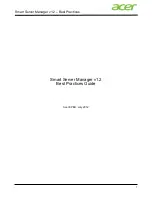
Chapter 26. An Introduction to Disk Partitions
272
/dev/
This is the name of the directory in which all device files reside. Since partitions reside on hard
disks, and hard disks are devices, the files representing all possible partitions reside in
/dev/
.
xx
The first two letters of the partition name indicate the type of device on which the partition resides,
usually either
hd
(for IDE disks) or
sd
(for SCSI disks).
y
This letter indicates which device the partition is on. For example,
/dev/hda
(the first IDE hard
disk) or
/dev/sdb
(the second SCSI disk).
N
The final number denotes the partition. The first four (primary or extended) partitions are
numbered
1
through
4
. Logical partitions start at
5
. So, for example,
/dev/hda3
is the third
primary or extended partition on the first IDE hard disk, and
/dev/sdb6
is the second logical
partition on the second SCSI hard disk.
Note
There is no part of this naming convention that is based on partition type; unlike DOS/
Windows,
all
partitions can be identified under Red Hat Enterprise Linux. Of course,
this does not mean that Red Hat Enterprise Linux can access data on every type of
partition, but in many cases it is possible to access data on a partition dedicated to
another operating system.
Keep this information in mind; it makes things easier to understand when you are setting up the
partitions Red Hat Enterprise Linux requires.
26.1.6. Disk Partitions and Other Operating Systems
If your Red Hat Enterprise Linux partitions are sharing a hard disk with partitions used by other
operating systems, most of the time you will have no problems. However, there are certain
combinations of Linux and other operating systems that require extra care.
26.1.7. Disk Partitions and Mount Points
One area that many people new to Linux find confusing is the matter of how partitions are used and
accessed by the Linux operating system. In DOS/Windows, it is relatively simple: Each partition gets a
"drive letter." You then use the correct drive letter to refer to files and directories on its corresponding
partition.
This is entirely different from how Linux deals with partitions and, for that matter, with disk storage
in general. The main difference is that each partition is used to form part of the storage necessary
to support a single set of files and directories. This is done by associating a partition with a directory
through a process known as
mounting
. Mounting a partition makes its storage available starting at the
specified directory (known as a
mount point
).
For example, if partition
/dev/hda5
is mounted on
/usr/
, that would mean that all files and
directories under
/usr/
physically reside on
/dev/hda5
. So the file
/usr/share/doc/FAQ/txt/
Linux-FAQ
would be stored on
/dev/hda5
, while the file
/etc/gdm/custom.conf
would not.
Summary of Contents for ENTERPRISE LINUX 5 - VIRTUAL SERVER ADMINISTRATION
Page 12: ...xii ...
Page 20: ......
Page 30: ...12 ...
Page 32: ...14 ...
Page 82: ...64 ...
Page 106: ...88 ...
Page 122: ...104 ...
Page 124: ...106 ...
Page 126: ......
Page 132: ...114 ...
Page 168: ...150 ...
Page 182: ...164 ...
Page 192: ...174 ...
Page 194: ......
Page 236: ...218 ...
Page 238: ...220 ...
Page 270: ......
Page 274: ...256 ...
Page 278: ...260 ...
Page 292: ...274 ...
Page 294: ......
Page 300: ...282 ...
Page 304: ......
Page 316: ...298 ...
Page 370: ...352 ...
Page 384: ...366 ...
Page 385: ...Part VII Appendix ...
Page 386: ......
















































